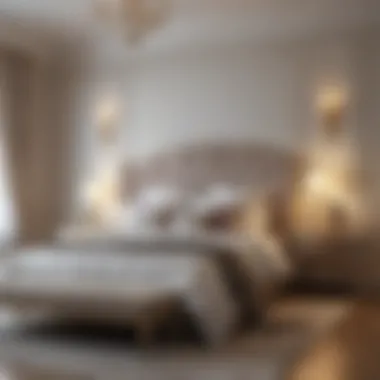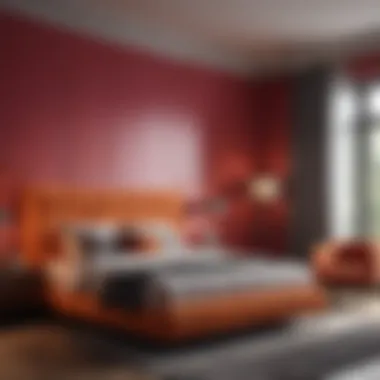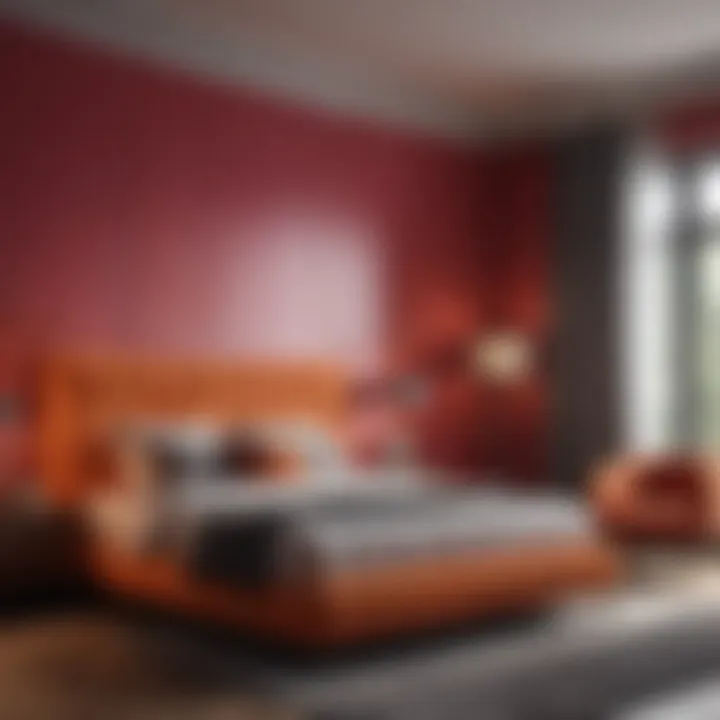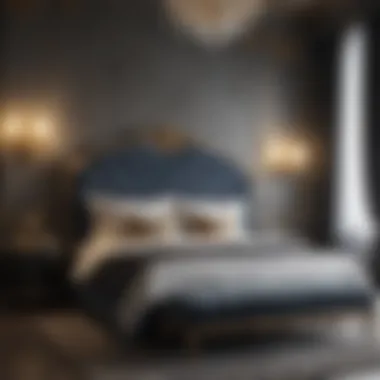Elegant Ideas for Beautiful Bedroom Decoration


Intro
A beautiful bedroom is more than just a place to sleep. It is a sanctuary that reflects personal style and offers comfort. The process of decorating a bedroom involves careful consideration of various design elements. This article provides practical insights and innovative ideas, aimed toward housewives and homeowners, who wish to elevate their bedroom spaces.
Design Inspirations
Latest Trends in Bedroom Design
Contemporary bedroom design often blends functionality with aesthetics. Key trends include minimalism, incorporating natural materials, and the use of smart home technology. Minimalist designs often rely on clean lines and uncluttered spaces. Natural materials like wood, cotton, and stone add warmth and texture. Smart technology aids in convenience and comfort, allowing control over lighting and temperature.
Some popular choices include:
- Adjustable LED lighting
- Smart thermostats
- Built-in speakers
Color Palettes and Themes
Choosing the right color palette is crucial for setting the mood in a bedroom. Neutral colors, such as beige and gray, provide a calm environment. They serve as a backdrop for more vibrant accents. Meanwhile, bold colors like deep blue or emerald green can evoke a sophisticated atmosphere.
When selecting a theme, consider the following options:
- Scandinavian: Focuses on simplicity and functionality, often featuring whites and light woods.
- Bohemian: Emphasizes eclectic patterns and colors, filled with personal items and textures.
- Modern Farmhouse: Combines rustic charm with contemporary comforts, typically using whites with black and wooden elements.
Functional Elements
Space Optimization Tips
An organized space enhances both functionality and aesthetics. Here are vital tips for optimizing bedroom space:
- Declutter Regularly: Keep only items that add value or serve a purpose.
- Use Vertical Space: Consider tall shelves or wall-mounted storage solutions.
- Create Zones: Differentiate areas for sleeping, studying, and relaxing.
Multi-Functional Furniture Choices
In a bedroom, space can be limited. Multi-functional furniture is an excellent solution. Some examples include:
- Murphy beds: Fold down when needed and save space when stored.
- Ottomans with storage: Provide seating and keep extra items out of sight.
- Convertible desks: Useful for work that can be folded when not in use.
Intro to Bedroom Decoration
In the realm of interior design, bedroom decoration stands as a vital aspect of creating a personal sanctuary. The bedroom is often viewed as a retreat from the world, making its decor paramount to fostering relaxation and well-being. A well-designed bedroom transcends mere aesthetics; it blends functionality with comfort, tailored to individual needs and preferences. Consider the emotional and psychological impact that colors, layouts, and furnishings can have. Each element contributes not just to appearance but to the overall ambiance of the space.
Importance of a Well-Designed Bedroom
A thoughtfully decorated bedroom goes beyond superficial beauty. It serves as a space for rest, rejuvenation, and privacy. When designed well, it can enhance productivity, promote better sleep, and elevate mood. Studies indicate that bedroom environments significantly affect mental health. For example, a cluttered or dark space may induce feelings of stress, while a well-lit and organized room can inspire tranquility.
Ensuring the bedroom meets one's needs also plays a role in this design. For instance, a person working from home may require a separate study area to increase focus during work hours. Thus, functional furniture choices are essential, supporting both leisure and productivity.
Overview of Current Trends
Current trends in bedroom decoration reflect a blend of innovation and timeless design principles. Minimalism remains popular, emphasizing clean lines and simplicity. This approach provides a sense of calm and order. Meanwhile, biophilic design is gaining traction, integrating nature into the bedroom to improve air quality and psychological health.
Colors play a significant role in these trends. Soft tones, such as pastels, have become a favored choice, promoting relaxation. Darker hues, like deep blues and forest greens, are also prevalent, providing a sense of coziness and depth. Textures have also emerged as a crucial aspect, encouraging layers through textiles and materials. Here are a few notable trends:
- Sustainable Materials: Increasingly, people opt for eco-friendly options, reflecting social responsibility.
- Tech Integration: Smart home features are making their way into bedroom design, enhancing convenience and comfort.
- Personalization: Unique decor choices that reflect personal heritage or experiences resonate with many homeowners today.
"A beautifully designed bedroom is a harmony of personal touch, comfort, and functionality, reflecting one’s lifestyle and preferences."
In summary, understanding the importance and current trends in bedroom decoration is essential for creating a space that is not only visually pleasing but also truly reflective of its inhabitant's personality and lifestyle.
Understanding Color Theory
Color theory is a crucial aspect of bedroom decoration. It plays a role in setting the tone and atmosphere of the space. The appropriate selection of colors can transform a room, affecting both aesthetics and mood. In a bedroom, where comfort and relaxation are paramount, understanding how colors interact and influence our emotions is essential. By mastering color theory, home decorators can craft spaces that resonate with their personal tastes while also promoting well-being.
Choosing a Color Palette
Selecting a color palette is not a simple task. It requires consideration of various factors such as room size, lighting, and personal preference. A well-chosen color palette establishes a foundation for the entire decor. Here are some key points to keep in mind:
- Consider the Room’s Size: Lighter colors can make a small bedroom feel larger and more open, while darker colors add coziness.
- Lighting Conditions: The amount of natural light a room receives can change how colors appear. Test paint samples in different lighting to see how they look at various times of day.
- Personal Style: Choose colors that reflect your personal taste. This could be bold and vibrant or soft and pastel.
- Flow with Adjacent Rooms: Ensure your color palette harmonizes with nearby rooms for a cohesive look in your home.
A structured color palette typically involves a dominant color and one or two accent colors. This method creates balance and visual interest without overwhelming the senses.
Impact of Colors on Mood
Colors have a profound effect on mood and can influence feelings in significant ways. Research shows that certain colors evoke specific emotions and reactions. Consider the following:
- Blue: Often regarded as calming and tranquil, blue can help reduce stress and promote peace. It is a popular choice for bedrooms.
- Yellow: Considered cheerful and uplifting, yellow can provide a sense of warmth. However, excessive use may become overstimulating.
- Green: Associated with nature, green fosters tranquility and balance. It is particularly suitable for rest and relaxation.
- Red: Intense and passionate, red can create excitement but may also increase heart rates. It is wise to use red as an accent color rather than the primary choice in a bedroom.
"The right colors can change not just a room, but how you feel in that room."
Furniture Selection
Furniture selection plays a crucial role in bedroom decoration. It influences not only the overall aesthetics but also the functionality of the space. When choosing furniture, consider elements such as size, style, and material, as these will impact how the room feels and operates. Proper furniture selection can enhance comfort, create an inviting atmosphere, and optimize the available space.
Essential Furniture Pieces
In every bedroom, certain furniture pieces are essential. The bed is the most important element, serving as the focal point of the room. When selecting a bed, consider the size, style, and the materials used. For example, a sturdy wooden bed frame can add warmth, while a sleek metal frame offers a modern touch.
Nightstands are another important piece. They should complement the bed and room's overall design. Consider functionality as well; they can house lamps, books, or personal items conveniently. Storage options such as dressers are also necessary. They offer space to keep clothes organized and can double as decorative surfaces for personal items.
Additional pieces like comfortable seating or ottomans can enhance usability. Plan the layout carefully to ensure natural movement within the space while avoiding clutter.
Space Optimization Techniques
Maximizing space is essential, especially in smaller bedrooms. One effective technique is to choose multipurpose furniture. For example, a bed with built-in storage drawers beneath can be very beneficial. It utilizes often wasted space and keeps the room tidier.


Wall-mounted furniture can also save floor space. Shelves or floating nightstands free up room and give an illusion of a larger area.
Similarly, consider choosing lighter colors for your furniture. This can help the room appear bigger and brighter. Mirrors are another excellent tool. They reflect light, making the room feel airy and spacious.
Ultimately, the goal of space optimization is to create a balance between functionality and style, ensuring the bedroom feels cozy and well-appointed without overcrowding.
Textiles and Materials
Textiles and materials play a very crucial role in bedroom decoration. They contribute not only to the aesthetics of a space but also to its comfort and functionality. The right choice of fabrics can significantly elevate the overall ambiance and enhance personal well-being. With numerous options available, it is important to select materials that reflect one’s taste while meeting practical needs such as durability, ease of care, and suitability to the bedroom’s theme.
Bedding Choices and Considerations
When selecting bedding, various factors come into play. First, consider the fabric. Options like cotton, linen, and microfiber have different properties. Cotton is breathable and easy to wash, making it suitable for year-round use. Linen offers a more textured feel but requires more maintenance. Microfiber is known for its softness and durability, ideal for families with children or pets.
The choice of bedding colors and patterns can also impact the room's atmosphere. Softer shades create a calming effect, while vibrant patterns can serve as focal points. Additionally, layering different textures can add depth and interest. For instance, combining a smooth cotton sheet with a knitted blanket achieves both comfort and visual appeal.
Pillows and pillow arrangements should not be forgotten. Mixing different sizes and forms adds dimension to the bed and can enhance comfort. Aim for a balance between decorative pillows and those intended for sleeping. Ultimately, the goal is to choose bedding that reflects personal style and facilitates restful sleep.
Curtains and Rugs for Comfort
Curtains and rugs are essential textiles that further enhance the bedroom's comfort. They are functional but also serve as key decorative elements. Selecting curtains involves considering both practicality and aesthetic appeal. For instance, blackout curtains provide privacy and help block out light, making them ideal for bedrooms. On the other hand, sheer curtains can create an airy feel while allowing natural light to filter in.
When choosing rugs, factor in size and placement. A rug should anchor the space; thus, it should be large enough to fit under key furniture pieces, such as the bed and side tables. Opting for a soft, plush rug can also add warmth underfoot, enhancing comfort during colder months. Textured rugs, such as shag or woven designs, can provide visual contrast to smooth surfaces.
Furthermore, both curtains and rugs should align with the room's color scheme and theme. A cohesive look creates harmony and enhances the overall aesthetic appeal. It is also advisable to consider the maintenance and durability of fabrics chosen, as this will affect their longevity in the space.
Lighting Solutions
Lighting is a crucial aspect of bedroom decoration. It shapes the overall feel of the space, contributing to both functionality and ambiance. The right lighting can make a room feel warm and inviting or bright and energizing. It influences the way we perceive colors and textures in the decor, helping to emphasize our design choices. Using a blend of various lighting types enhances not just aesthetic appeal but also promotes comfort and well-being in the bedroom.
Natural vs. Artificial Lighting
Natural light offers several advantages in a bedroom. It helps to regulate our circadian rhythms, promoting better sleep and wake cycles. Large windows or skylights can flood the space with sunlight, making it feel larger and brighter. However, excessive sunlight can cause glare or fade textiles and furniture over time.
On the other hand, artificial lighting serves to complement and control the absence of natural light. Options like ceiling lights, bedside lamps, and wall fixtures allow for versatility, catering to different activities such as reading or relaxing. When selecting lighting, consider both types. Use natural light during the day and employ artificial sources for nighttime.
- Pros of Natural Lighting:
- Cons of Natural Lighting:
- Improves mood and reduces stress
- Saves energy during daylight hours
- Enhances color fidelity in decor
- May cause overheating in summer
- Can be limited by window size or orientation
- Requires window treatments for privacy
Layering Light Sources
Layering light is about combining different lighting types for a balanced effect. This strategy enhances functionality and mood. Typically, three layers are used: ambient, task, and accent lighting.
- Ambient Lighting: This is the primary source of illumination in the room. Ceiling fixtures or recessed lights provide general brightness, not overwhelming but enough to light the space.
- Task Lighting: Specific areas like reading nooks or workspaces require focused lighting. Table lamps or wall-mounted fixtures designed for tasks can prevent eye strain and create a welcoming atmosphere for work.
- Accent Lighting: This adds drama and highlights specific features. Use it to illuminate artwork, architectural details, or decorative accessories.
"A well-lit room can change perception, enhance mood, and define each area by its function."
Incorporating these layers allows for flexibility—altering the lighting can shift the room’s entire mood. Consider dimmable switches to control intensity, adapting the space for different activities seamlessly.
By balancing these elements, one achieves a well-designed, functional, and aesthetically pleasing environment.
Wall Treatments
Wall treatments play a significant role in bedroom decoration. They can instantly transform a space, providing character and atmosphere. The choice of wall treatment can influence the overall design aesthetic and feel of a room. This section aims to explore two key aspects: the difference between paint and wallpaper, and innovative ideas for wall decor. Understanding these elements can help you to create a personalized atmosphere that aligns with your vision.
Paint vs. Wallpaper
The decision between paint and wallpaper depends on various factors, including your style, budget, and maintenance preferences. Paint offers a smoother finish and is generally less expensive than wallpaper. It also provides an easy way to change colors when you want a new look. Moreover, painted walls are often easier to keep clean; a simple wipe can remove most stains.
On the other hand, wallpaper can present unique textures and patterns that might not be achievable with paint alone. It can add depth and interest to your walls. However, it may require more effort in installation and removal. Some might find that they prefer the intricate designs available through wallpaper, especially if they want to create a statement wall.
When comparing the two options, consider:
- Durability: Wallpaper can last for many years if maintained properly.
- Design Variety: Paint allows for a wide variety of colors, while wallpaper offers patterns and textures.
- Application and Removal: Paint is generally easier to apply and remove versus wallpaper, which can be a more tedious task.
In summary, choose paint if you prefer flexibility and a fresh look often. Opt for wallpaper if you enjoy intricate designs and textures.
Innovative Wall Decor Ideas
To elevate your bedroom walls beyond basic treatments, consider implementing innovative decor ideas. Here are a few suggestions:
- Gallery Walls: Create a personalized gallery wall using framed art, photographs, and decorative mirrors. Mixing different frame styles can create a visually appealing arrangement.
- Floating Shelves: Install floating shelves to display books, plants, or personal items. They add functionality and make the walls dynamic.
- Bold Accent Walls: Paint one wall in a bold color or use a contrasting wallpaper, making it a focal point in the room.
- Wall Decals or Stickers: Easy to apply and remove, wall decals offer a simple way to change the look whenever you desire.
"The wall decor you choose reflects your personality and makes your space uniquely yours."
These ideas can enhance the character of your room while allowing yourself to express creativity. Exploring options for wall treatments is vital for developing a bedroom that is both beautiful and functional. Remember, the right decision will lead to a harmonious bedroom environment.
Accessorizing the Space
Accessorizing the space is a crucial aspect of bedroom decoration. It does not just add aesthetic appeal; it also reflects personal style and enhances the overall ambience of the room. Accessories can elevate a simply designed room into a haven of style and comfort. The choices you make in terms of decor elements can convey warmth, character, and individual taste.
When selecting accessories, think about items that harmonize with your chosen color palette and furniture style. This may include items such as artwork, decorative pillows, and meaningful trinkets. These elements should not overwhelm the space but rather enhance its overall look. Finding the right balance is essential.
Moreover, accessorizing often brings an opportunity for seasonal changes. By rotating accessories throughout the year, you keep the room feeling fresh and new. It's an effective way to incorporate trends without doing a complete overhaul.
Art and Decorative Objects
Art and decorative objects serve as focal points within the bedroom. They bring color, interest, and depth to the space. Selecting the right pieces is not merely about decoration; it is about creating an environment that resonates with you.
When choosing art, consider both the theme of your bedroom and your personal preferences. A large abstract painting might be perfect for a modern setting, while a collection of vintage photographs might suit a more classic style. Do not shy away from bold pieces as they can serve as conversation starters and can inject energy into the room.


Also, decorative objects like sculptures or unique vases can add texture and variety. Group these items in odd numbers for a balanced yet casual look. Try to mix sizes and materials for depth. Glass, wood, and metal can create an interesting contrast, making the space feel dynamic.
Personal Touches and Decorations
Personal touches are what make any space feel like home. They tell your story and provide insight into your personality. Items such as family photos, handmade crafts, or souvenirs from travels add layers to the space.
Be mindful of how and where you display these personal items. An arrangement on a bedside table or a dedicated shelf can create a curated feel. Use frames that complement your bedroom's style for a cohesive look.
Further, incorporating sentimental objects resonates deeply on an emotional level. They can include books you love, mementos from special occasions, or even heirlooms. Displaying these items transforms your room from just a sleep space to a comforting retreat.
"Accessorizing is not just about filling a room with things; it’s about creating a personal sanctuary that reflects who you are."
Creating a Cohesive Look
A cohesive look in bedroom decoration leads to a harmonious environment that reflects the individual’s taste and lifestyle. When every element in the room complements the others, it creates a sense of unity and balance. The goal is to achieve visual coherence without sacrificing personal style. This involves considering color schemes, furniture styles, and decorative accents that work well together.
In achieving a cohesive look, one should start with a clear vision. Begin by selecting a central theme or style. This could be modern, rustic, or perhaps a blend that suits your preferences. Once you have a theme, every choice should align with that vision. This not only simplifies the decorating process but also avoids mismatches that can disrupt the space's feel.
Harmonizing Styles and Themes
Blending various design styles can lead to exciting results, but it requires skill. Taking inspiration from your favorite aesthetics can be beneficial. For instance, if you prefer modern elements but appreciate vintage charm, mix furniture pieces accordingly. A sleek modern bed frame paired with antique nightstands can create an intriguing mix if balanced well.
Make sure that colors reflect the chosen style. For example, neutral tones often provide the perfect base for both modern and vintage accents. Accent colors should enhance the overall palette, tying everything together without overwhelming the senses.
Balancing Functionality with Aesthetics
While aesthetics are important for visual appeal, functionality plays a crucial role in the bedroom design. Create spaces that are not only beautiful but also serve practical purposes. For instance, selecting storage solutions that fit the room's style while keeping clutter at bay is essential. Shelving units or stylish storage boxes can blend seamlessly into the decor.
Moreover, layout affects both the look and feel of the bedroom. Ensure that every piece serves a purpose, whether it draws the eye or provides utility. A well-defined space encourages comfort and relaxation.
"A well-coordinated bedroom can significantly influence one's mood and productivity."
Thus, balancing aesthetic choices with functional needs is vital in creating a bedroom that is both inviting and practical. Each element contributes to the narrative of the space, further enhancing its cohesive look.
Sustainable Practices in Bedroom Design
In recent years, sustainability has emerged as a fundamental aspect of interior design. Sustainable practices in bedroom design not only support environmental well-being but also enhance the overall aesthetic and functional quality of the space. By focusing on sustainable elements, homeowners can create bedrooms that are both beautiful and responsibly designed.
Eco-Friendly Materials
Choosing eco-friendly materials is crucial in sustainable bedroom design. Materials such as bamboo, reclaimed wood, or natural fiber textiles can significantly reduce the environmental footprint of the space.
- Bamboo: Bamboo grows rapidly and requires minimal resources to thrive. It is durable and can be used for flooring, furniture, and decor.
- Reclaimed Wood: Utilizing wood from old furniture or construction sites minimizes waste and adds character to the bedroom. Each piece tells a story and often features unique imperfections.
- Natural Fiber Textiles: Fabrics made from organic cotton or linen are not treated with harmful chemicals, making them safer for the environment and healthier for occupants.
Incorporating these materials leads to a more sustainable bedroom while promoting a healthy living environment. It is essential to check certifications, like OEKO-TEX or FSC, to ensure materials meet eco-friendly standards.
Upcycling Ideas for Bedrooms
Upcycling is an innovative way to give new life to old items without the need for new materials. This practice reduces waste and can lead to unique, personalized decor.
Here are several upcycling ideas for bedrooms:
- Old Furniture Revival: Consider refinishing a dated dresser or nightstand with eco-friendly paints. Adding new hardware can also modernize these pieces and extend their life rather than discarding them.
- DIY Headboards: Old doors or wooden pallets can be transformed into stunning headboards. Sanding down the surfaces, applying a fresh coat of paint, or staining can create a focal point above the bed.
- Storage Solutions: Vintage suitcases, crates, or jars can serve as stylish storage options. They add character while helping to maintain an organized bedroom.
- Gallery Wall: Repurpose old frames with new art or photographs. Group them in a creative layout to make a statement without purchasing mass-produced items.
By embracing upcycling, homeowners not only save money but also contribute to a circular economy. Each upgraded item carries personal significance and enhances the bedroom's charm.
Tips for Seasonal Decoration Changes
Importance of Seasonal Decoration Changes
Adapting your bedroom decor to reflect the seasons can transform your space into a fresh environment. It brings new energy and can influence your mood positively. Seasonal changes often prompt us to rethink our living spaces, providing an opportunity to innovate and recreate. This section will explore how seasonal changes impact interior design, allowing for a dynamic relationship between your personal space and the external environment.
Adapting Decor for Different Seasons
When adapting decor for different seasons, consider a few key elements that can enhance the mood of your bedroom:
- Seasonal Colors: Bright colors can breathe life into your room in spring and summer, while warm, earthy tones provide a cozy feel during fall and winter. Changing bed linens, cushions, and artwork according to the season helps maintain a lively atmosphere.
- Textiles and Fabrics: Using lighter materials such as linen and cotton for warmer months promotes comfort, while switching to heavier textures like wool or velvet during colder months creates warmth and intimacy.
- Accessories: Update your decorative items to reflect seasonal themes or colors. For example, incorporate floral arrangements in spring and greenery during summer. Additionally, winter can be enhanced through the use of candles and soft, ambient lighting.
Maintaining a Fresh Look
Keeping your bedroom decor fresh is essential for creating a comfortable living space. Here are some tips on how to achieve this:
- Regular Changes: Try to change elements in your room every few months. This could involve rotating artwork, changing pillow covers, or introducing new decorative objects.
- Decluttering: A thorough decluttering enhances the overall look and feel of the space. Removing items that no longer serve a purpose or that clutter the environment helps in maintaining a clean and airy space.
- Incorporate Personal Touches: Personalize your bedroom by adding items that resonate with you. This could include photographs, books, or travel souvenirs that bring back positive memories.
"Regular changes in decor can bring new life into your space and keep it vibrant."
In summation, seasonal decoration changes are not only about aesthetics but also about feelings and experiences. Adapting your bedroom to reflect seasonal variations helps create an inviting atmosphere, fostering a strong sense of belonging and comfort.
DIY Projects for Personalization
Personalizing a bedroom can transform it into a reflection of one’s personality. DIY projects are critical in achieving this goal. They offer a unique opportunity to incorporate personal tastes and creativity into the décor. Furthermore, these projects often come with cost-effective advantages compared to buying ready-made items. By engaging in DIY, individuals can also create bespoke pieces that resonate deeply with their preferences.
When embarking on DIY projects, it is essential to consider the materials and tools needed. Choosing the right elements can severely affect the final outcome. Additionally, practical skills can be developed and honed over time, leading to greater confidence in one’s ability to tackle larger projects. The benefits extend beyond mere decoration; these activities can also serve as therapeutic outlets, fostering a sense of achievement and satisfaction.
Simple DIY Decor Ideas
Creating simple DIY decor ideas does not have to be overwhelming. Start with small projects that can make a significant impact. For example:
- Homemade Wall Art: Use canvases and acrylic paint to design unique art pieces. Abstract designs or even simple shapes can brighten a wall.
- Photo Collage: Gather favorite memories and use an array of frames to create a personal photo gallery. This adds warmth to the space.
- Stylized Throw Pillows: Sew or simply repurpose old fabrics to create chic throw pillows. Adding personal touches like monograms can enhance their uniqueness.
These projects are easily achievable and add a personal touch without overwhelming the design aesthetic of the bedroom.
Furniture Upcycling Techniques


Furniture upcycling opens a world of possibilities to revitalize older items. It combines sustainability with creativity, resulting in functional pieces that fit well in modern settings. Here are a few useful techniques to consider:
- Painting: A fresh coat of paint can completely change the appearance of wooden furniture. Choosing bold colors or even pastels can adapt the furniture to current design trends.
- Decoupage: Utilize decorative paper or fabric to cover surfaces like drawers or table tops. This technique allows for intricate designs tailored to personal taste.
- Hardware Replacement: Sometimes, simply changing knobs or handles can give a fresh look. Opt for vintage or modern pieces according to style preference.
These methods allow for extensive creativity, enabling individuals to transform their bedrooms on a budget while preserving beloved furniture.
Technology in Bedroom Design
The integration of technology in bedroom design has become significant for modern living. With the rapid advancements in smart home technology, the bedroom can now be transformed into a more functional and comfortable space. This section will explore the different facets of technology in bedroom design, focusing on smart features and how technology contributes to comfort.
Smart Bedroom Features
Smart bedroom features make life easier and enhance the overall living experience. These include smart lighting systems, temperature control devices, and multifunctional furniture. Incorporating these technologies can effectively change the atmosphere of the bedroom with minimal effort.
- Smart Lighting: Adjustable. Smart bulbs can change brightness and color, allowing for customization to suit your mood or times of day. Some systems can sync with your sleep cycle.
- Smart Thermostats: Control room temperature remotely or set schedules for warmth during winter. Brands like Nest or Ecobee enable comfort while being energy efficient.
- Automated Window Treatments: Motorized blinds or curtains can be programmed to open or close at certain times. This helps to control light and privacy with ease.
These features not only bring convenience but also blend with design aesthetics, providing both beauty and functionality.
Integration of Technology for Comfort
Integrating technology into the bedroom environment can significantly improve comfort levels. Bluetooth speakers, sleep tracking devices, and even smart beds are examples of how technology influences rest and relaxation.
- Smart Beds: These beds can adjust firmness, incline, and even monitor sleep patterns. Brands like Sleep Number offer flexibility tailored to individual preferences.
- Sound Machines and Bluetooth Speakers: These help in creating a serene atmosphere. Gentle sounds can lull individuals to sleep and improve focus during the day.
- Sleep Trackers: Devices or apps that monitor sleep quality and patterns can provide valuable insights. Implementing the suggested changes can lead to better sleep hygiene and health.
Utilizing technology in bedroom design is not just about aesthetics; it is about creating a space that fosters well-being.
By adopting these technologies, homeowners can genuinely enhance their bedroom experience. Embracing these innovations makes daily living more enjoyable and promotes a restful environment.
Cultural Influences on Bedroom Design
Cultural influences play a significant role in bedroom design. Understanding these influences allows homeowners to create spaces that reflect personal identities and cultural backgrounds. Each culture has unique traditions, symbols, and aesthetics that can enhance the beauty of a bedroom. By integrating various cultural elements, individuals can create a space that is not just functional but also meaningful.
Exploration of Global Styles
Global styles in bedroom design reflect diverse cultural motifs and philosophies. These styles offer inspiration drawn from various corners of the world. Each style contributes distinctive characteristics. For example, Japanese minimalism emphasizes clean lines and functionality, focusing on simplicity, which resonates with a clutter-free environment.
In contrast, Indian decor often incorporates vibrant colors and intricate patterns through fabrics and decorative elements. The use of textiles such as silk or linen adds depth and richness, creating warmth. Meanwhile, Scandinavian design is characterized by its emphasis on light, pale wood, and a natural feel which promotes a stress-free atmosphere.
By embracing these global styles, homeowners can select elements that enrich their space.
- Japanese: Minimalist and functional, promoting simplicity.
- Indian: Rich in color and pattern, adding warmth.
- Scandinavian: Light and natural, focusing on comfort.
Exploring these global styles not only enhances aesthetics but can also introduce unique functional aspects specific to different cultures.
Traditional vs. Contemporary Elements
Balancing traditional and contemporary elements can significantly transform a bedroom. Traditional design captures history and craftsmanship, often utilizing antique furniture and classic designs. These elements evoke nostalgia and offer timeless appeal. On the other hand, contemporary designs embrace innovation, focusing on lines, materials, and functionality.
Ultimately, striking a balance between these styles can create an inviting space that honors heritage while being practical for modern living. This approach can also resonate with a wider audience.
A few considerations when combining these approaches include:
- Furniture Selection: Mixing a vintage dresser with modern decor can create visual contrast.
- Color Palette: Neutral shades can harmonize traditional and modern accents.
- Textiles: Layering modern fabrics with traditional patterns adds depth.
"The best bedroom designs reflect a person’s story through cultural influences, balancing heritage with modern living."
In summary, cultural influences significantly shape bedroom design. By exploring global styles and thoughtfully combining traditional and contemporary elements, one can achieve a beautifully decorated bedroom that tells a personal story and utilizes effective design principles.
Psychology of Space and Arrangement
Understanding the psychology of space and arrangement is crucial for creating a bedroom that is not only attractive but also conducive to well-being. The way a room is organized can significantly affect a person's mood, stress levels, and overall quality of life. Thoughtful arrangement allows for functionality while promoting relaxation and comfort.
Impact of Layout on Well-Being
The layout of a bedroom plays an essential role in supporting its occupants' well-being. A well-planned space can foster feelings of tranquility and safety. Here are some considerations:
- Flow: Ensure the arrangement allows for easy movement. Crowded pathways can lead to unnecessary stress and discomfort.
- Functional Zones: Designate specific areas for different activities, such as sleeping, dressing, and relaxing. This delineation helps in maximizing the use of space and in cultivating a sense of order.
- Viewing Angles: Require consideration of how one will interact with the room. Positioning the bed to face the door can create a sense of security.
"A thoughtfully designed layout provides not only aesthetic pleasure but enhances psychological comfort."
The alignment of furniture also influences one’s emotional state. For example, soft curves and rounded corners may offer calmness, while angular lines can suggest rigidity and order.
Spatial Relationships and Their Importance
Spatial relationships encompass how different elements within the room connect to one another. This harmony is vital for determining comfort levels and aesthetic coherence. To explore this further, some key aspects include:
- Proportions: The size of furniture relative to room dimensions affects how enclosed or spacious the area feels. Oversized furniture in a small room can create a constricted atmosphere, negatively impacting mood.
- Symmetry and Balance: Achieving balance through symmetrical arrangements can evoke feelings of peace and stability. For example, nightstands on either side of a bed can visually anchor the space.
- Connection with Nature: Incorporating natural elements or views can enhance tranquility. This is beneficial in bedrooms where light and nature can be integrated, impacting mood positively.
Applying the principles of spatial psychology in bedroom arrangement ultimately leads to a more harmonious living space. Ensuring that your personal sanctuary supports peace and relaxation can transform your daily experience.
Finale and Future Trends
Recap of Key Elements
A successful bedroom design encompasses several essential components. First, color theory plays a pivotal role. Choosing the right palette can significantly influence the mood and atmosphere of the room. Next, furniture selection is paramount. Opting for essential pieces that fit well within the space ensures functionality without overcrowding. Moreover, lighting solutions should not be overlooked; they help to enhance the space’s overall appeal and can alter how colors appear in different settings.
Textiles and materials contribute drastically to the comfort of the bedroom. Quality bedding, curtains, and rugs not only provide comfort but also add layers of visual interest. Wall treatments serve as a canvas for expressing personal style, whether through paint, wallpaper, or innovative decor ideas. Lastly, accessorizing the space with art and personal touches imparts a unique identity to the room.
Emerging Trends in Bedroom Design
As we look to the future, several emerging trends are reshaping bedroom design. A notable shift towards sustainability is evident, with a growing preference for eco-friendly materials. Consumers are increasingly opting for items made from natural fibers and reclaimed wood, which aligns with their values of environmental responsibility.
Another trend is the integration of technology within bedroom spaces. Smart features, like automated lighting, temperature control, and even sound systems, are becoming commonplace, allowing for enhanced comfort and convenience.
Minimalism is gaining traction, encouraging individuals to declutter and focus on essential items that bring joy, as advocated by movements like Marie Kondo’s. This trend promotes a clean, simple aesthetic that can create a more peaceful sleep environment.
Lastly, the influence of global cultures and travel continues to inspire bedroom design. Homeowners are now incorporating diverse styles and elements from various regions, fostering unique spaces that tell personal stories.
In essence, bedroom design is not just about decoration; it’s about creating a retreat that nurtures well-being.
By being aware of these trends and incorporating well-understood key elements, anyone can transform their bedroom into a personal haven while keeping up with the evolving designs in decor.















